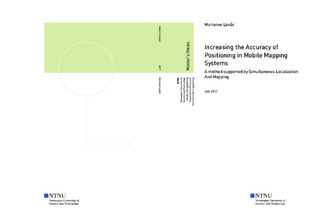| dc.description.abstract | In areas where GNSS satellite signals become weak or unavailable a period of time, accuracy of the positioning of mobile mapping systems based in aided inertial navigation can be drastically reduced. This can be problematic in, for instance, city areas with high buildings, forests and tunnels. An increased number of terrestrial land surveyed points can be necessary to get a sufficiently good accuracy of estimated trajectories in these areas. Extra surveyed points make the process more time and work consuming.
In mobile mapping, laser scanners are typically used to gather information about the surroundings, but they can also be used to find information about relative movement of the mobile mapping system. Taking advantage of Simultaneous Localization And Mapping (SLAM), the observations from the laser scanner can be used to aid inertial navigation when calculating the trajectory. Including SLAM in re-calculation of the trajectory can be done to improve the positioning accuracy of it. The improved trajectory can, in turn, be used to improve accuracy of the point cloud.
Potential methods for including SLAM have been developed and tested in this thesis. The first method presented is used to improve global consistency of the trajectory by the use of back-end SLAM. This is done by using loop closure events. The second method uses incremental observations to improve local consistency of the trajectory by the use of front-end SLAM.
A software package has been developed for transforming point cloud observations from TerraMatch to information that can be used in the SLAM algorithms as part of the trajectory calculation in TerraPos. A relative point cloud observation in TerraMatch is linked to the other point cloud observations of the same feature. The developed methods use this information to solve the data association problem in SLAM.
The methods have been tested in GNSS denied areas in the point cloud. Both the presented methods show an improved accuracy and precision of the trajectory by the use of SLAM to re-calculate it. Tests of the method using back-end SLAM show that the method has the potential to improve the trajectory when a part of the trajectory with low precision overlaps a part with high precision. Identification and removal of systematic errors was found to be important in the incremental observations used for the front-end SLAM method. | |

